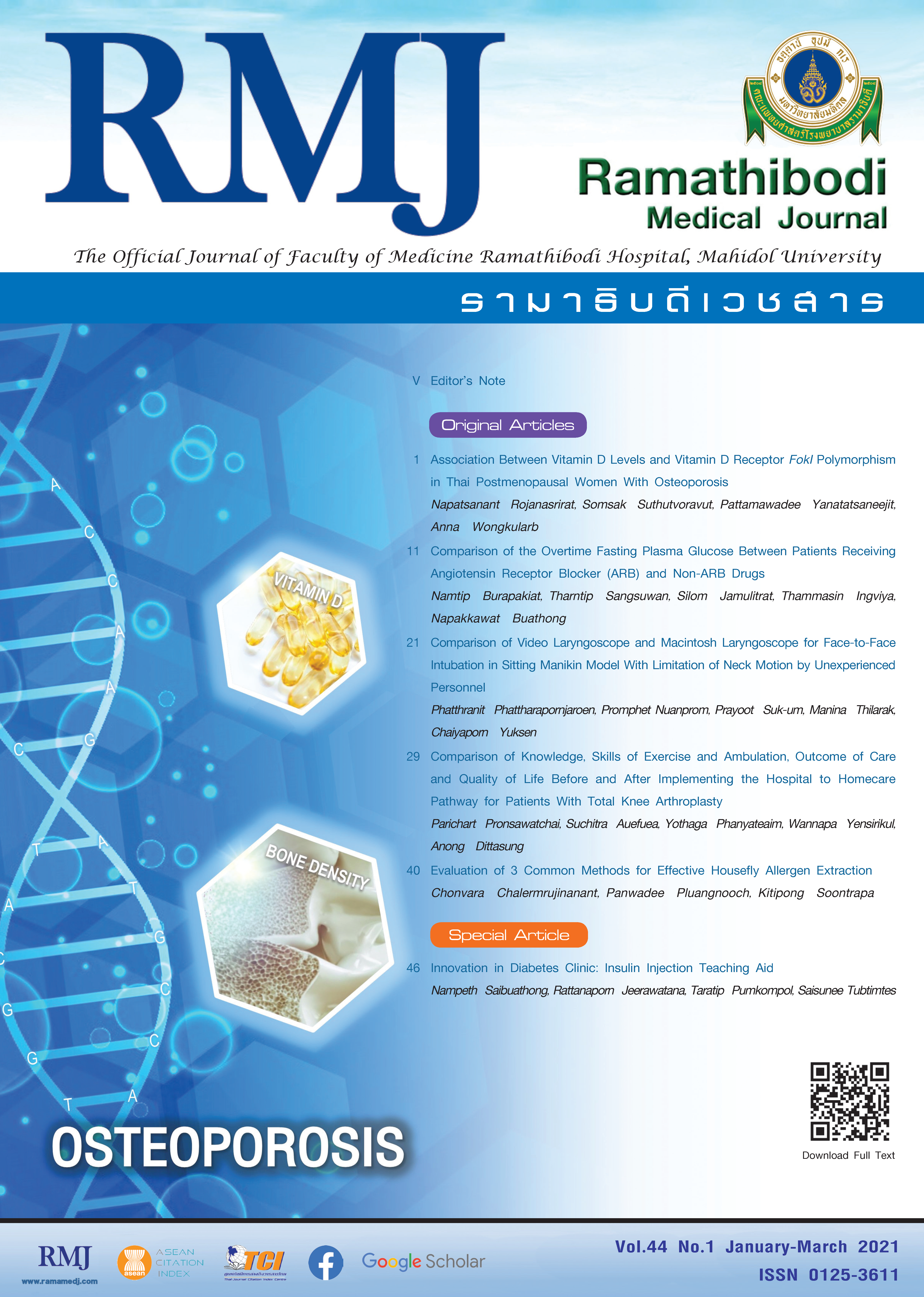Innovation in Diabetes Clinic: Insulin Injection Teaching Aid
DOI:
https://doi.org/10.33165/rmj.2021.44.1.174964Keywords:
Diabetes mellitus, Insulin, Injection teaching model, Abdomen modelAbstract
Background: Insulin injection education is important in diabetes mellitus patients’ treatment in order to control blood glucose levels.
Objective: To present a new innovative teaching method for insulin injection.
Methods: Samples included diabetes patients, who were taught the first insulin injection at the diabetes clinic, Ramathibodi Hospital. They were divided into 2 groups (35 patients in each group): the experimental group was taught by the abdomen model for injections, and the control group was instructed by a traditional lecture style. Three evaluation forms were used: 1) injection observation sheet; 2) self-evaluation sheet of understanding and injection skill of the diabetes patients; and 3) evaluate efficiency form of teaching insulin injection model.
Results: The study revealed that the experimental group understood injection methods both in terms of injection skills and confidence in self-injection at more than 97% except for fear. The study found that trypanophobia decreased 70.2% and fear of pain reduced 82.8%. The abdomen model teaching method yielded effective results to increase injection skills, knowledge, and understanding of self-injection.
Conclusions: This abdomen model is now used to teach insulin injection as a commercial product sold at the Center of Excellent Innovation, Faculty of Medicine Ramathibodi Hospital, Mahidol University. This model is currently used as one of the medical tools for teaching insulin injection at the diabetes mellitus clinic of the medical outpatient unit of Ramathibodi Hospital.
References
Siminerio L, Kulkarni K, Meece J, et al. Strategies for Insulin Injection Therapy in Diabetes Self-Management. American Association of Diabetes Educators; 2011. Accessed January 4, 2021. https://www.diabeteseducator.org/docs/default-source/legacy-docs/_resources/pdf/research/aade_meded.pdf?sfvrsn=2
Boehm BO, Vaz JA, Brøndsted L, Home PD. Long-term efficacy and safety of biphasic insulin aspart in patients with type 2 diabetes. Eur J Intern Med. 2004;15(8):496-502. doi:10.1016/j.ejim.2004.10.001
Baruah MP. Insulin pens: the modern delivery devices. J Assoc Physicians India. 2011;59 Suppl:38-40.
Pearson TL. Practical aspects of insulin pen devices. J Diabetes Sci Technol. 2010;4(3):522-531. doi:10.1177/193229681000400304
Ji J, Lou Q. Insulin pen injection technique survey in patients with type 2 diabetes in mainland China in 2010. Curr Med Res Opin. 2014;30(6):1087-1093. doi:10.1185/03007995.2014.895711
Yamauchi K. Analysis of issues of insulin self-injection in elderly. Nihon Ronen Igakkai Zasshi. 2009;46(6):537-540. doi:10.3143/geriatrics.46.537
Frid A, Hirsch L, Gaspar R, et al. The third injection technique workshop in Athens (TITAN). Diabetes Metab. 2010;36 Suppl 2:S19-S29. doi:10.1016/S1262-3636(10)70003-3
Stetson B, Boren S, Leventhal H, et al. Embracing the evidence on problem solving in diabetes self-management education and support. SelfCare. 2010;1(3):83-99. Accessed January 4, 2021. https://selfcarejournal.com/wp-content/uploads/2015/09/Stetson-1.3.83-99.pdf
Berard L, Cameron B. Injection technique practices in a population of Canadians with diabetes: results from a recent patient/diabetes educator survey. Can J Diabetes. 2015;39(2):146-151. doi:10.1016/j.jcjd.2014.10.003
Magwire ML. Addressing barriers to insulin therapy: the role of insulin pens. Am J Ther. 2011;18(5):392-402. doi:10.1097/MJT.0b013e3181ef4dde
Tubtimtes S, Saibuathong N, Pumkompol T, Jeerawatana R. Achievement of insulin injection training by skin model in diabetic patients. Journal of Health Science. 2017;26 (Suppl 1):S79-S88.

















